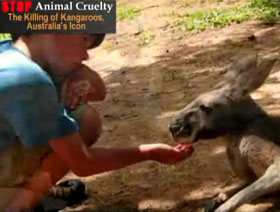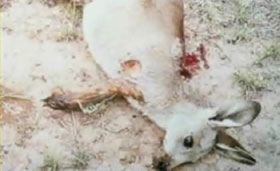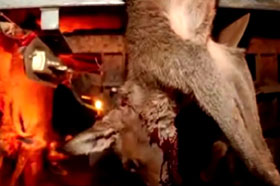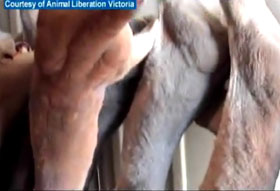The images in the following program are very sensitive and may be as disturbing to viewers as they were to us. However, we have to show the truth of animal cruelty.
HOST:
Caring viewers, welcome to Animal World: Our Co-Inhabitants. Today’s episode of our Stop Animal Cruelty series focuses on Australia’s proud national symbol, the endearing kangaroo. As we will see, despite their iconic status, kangaroos and their young, called joeys, are heavily persecuted and are nearly endangered due to the massive slaughtering of wildlife.
Let us hear more about the plight of beautiful beings from Nikki Sutterby, coordinator of the Australian Society for Kangaroos in Castlemaine, Victoria, Australia.
Nikki Sutterby(f):
Kangaroos have very strong family bonds in their mob (herd), they have very close relationships with their joeys. They’re reliant on their mother until they are about 18 months of age. They will feed from 
her, particularly in the Eastern Greys, and the daughters, the female joeys will stay with their mother for the rest of their life. And the big males are also a very important part of the hierarchy and social structure. They not only protect the female from the advances of younger males, they also teach the young joeys and have a lot of interaction with the young joeys, teaching them the rules of the group and survival skills. And the female kangaroos teach the young joeys also, the rules of the mob and how to look after their young and survive. So there are some very strong bonds within kangaroos.
People that raise kangaroos, they will tell you that they are extremely intelligent animals and extremely sensitive and they suffer a lot of grief when their family members are killed or when they’re stressed, and certainly there are stories of the mothers dying when their joey dies.
So a mother is a mother and these animals are suffering intensely under this cruel industry that’s going on night after night in Australia.
HOST:
Every year the fate of millions of kangaroos are set by the quota for the number to be killed for meat and for their skins to be made into leather products. In 2007, number of kangaroos slaughtered was 3.6 million kangaroos, or 10,000 innocent animals hunted every night purely for profit.
However, this does not include the number of kangaroos that are shot but escape capture or the helpless babies, the joeys, which are ruthlessly and barbarically bludgeoned to death. The true scale of the massacre may be two to three times higher.

The cruelty and suffering inflicted on these extremely sensitive animals is unimaginable. At night, hunters go out with spotlights to find and shoot them. Hunters shoot the helpless creatures through the head, neck, throat or jaw, causing massive bleeding and excruciating pain. If they survive the wounds, the kangaroos may flee into the outback and subsequently die of their horrific injuries, after suffering for days. Sometimes hunters deliberately shoot kangaroos in the neck so as to cause them to bleed out, thus making the flesh paler.
As consumers prefer eating whiter meat so with higher demand, it is thus more profitable. It has also been reported that some hunters deliberately avoid making a lethal shot, and instead shoot to down the animal so that it can be taken alive to the slaughterhouse. Again this is done out of greed as the fresher the meat, the more money it fetches.
When these downed kangaroos are loaded into trucks, their legs are broken and snapped in half in order to stop them from jumping away.
Kangaroos: Myths and Realities, is a book by a coalition of citizens and scientists who have joined to expose the myths underlying the persecution and exploitation of Australia’s kangaroo. Ms. Sutterby reads an excerpt in the book of an account by a former hunter. He tells of the cruelty of kangaroo killings.
Nikki Sutterby(f):
It talks about what actually happens to individual animals on a regular basis that you wouldn’t know about. “The mouth of a kangaroo can be blown off and the kangaroo can escape to die of shock and starvation later on. Forearms can be blown off, as can ears, eyes and noses. Stomachs can be hit expelling the contents with the kangaroos still alive. Backbones can be pulverized to an unrecognizable state. Hind legs can be shattered with the kangaroo desperately trying to get away on the other or without the use of either. To deny that this goes on is just an exercise in attempting to fool the public.”
HOST:
It has been estimated that up to 80% of the kangaroos killed each year in Australia are females. A female kangaroo usually carries a baby in her pouch and may also have a dependent child known as an “ex-pouch joey” accompanying her. When the mother is killed, the baby and child and of course her family, experience great distress. The baby in the pouch mostly does not survive and chanced are slim for the ex-pouch joey as well who was dependent on his mother for milk, protection and love and is now left to fend for itself.
Ms. Sutterby reads another excerpt from
Kangaroos: Myths and Realities on what awaits these orphaned children.
Nikki Sutterby(f):
One of the things he [author] talks about is: “Kangaroos have a social life, not unlike humans, with strong mother-and-joey ties, companions, relatives and the like. When continually shot, kangaroos fret for loved ones and their own lives, being forced to live in a state of spasmodic terror. Kangaroos can be and are horribly wounded. In-pouch joeys are bludgeoned to death. The out-of-pouch joeys, all alone for the first time in their short lives, and panic-stricken after witnessing the brutal death of their mother are left to die from starvation and/or hyperthermia and/or predation. The survivors live in a state of constant fear with proper social order in constant disarray and upheaval.”
HOST:
The method of killing of in-pouch babies is by decapitation; a sharp blade is used to cut off the babies’ heads. Other slaughtering methods include shooting joeys at close range, striking them with a metal pipe or forcefully swinging them against a solid metal object.
Conservative estimates suggest that more than a million babies suffer this fate every year, which is almost 3,000 joeys every night.
When Animal World: Our Co-Inhabitants returns, we will divulge more about the cruel industry involving Australia’s national symbol. Please keep your dial tuned here to Supreme Master Television.
HOST:
Thank you for joining us again for today’s Stop Animal Cruelty show on Animal World: Our Co-Inhabitants. We have been investigating the ruthless massacre of the gentle kangaroos that takes place daily in Australia.
Six species of kangaroos have already become extinct and 17 others are endangered. Since 2001, kangaroo numbers in Australia have declined by 65-80%. The red kangaroo is killed three times faster than it can reproduce. With the loss of kangaroos, the delicate balance of the ecosystem is disturbed.
Nikki Sutterby(f):
One of our leading ecologists, Dan Ramp, has actually done a lot of research and found that kangaroos actually play an integral role in the ecosystem’s functioning and they can actually be found to protect threatened species or endangered species from further decline. So more common species such as kangaroos and wombats actually have a very important role in the ecosystem’s functioning in Australia. In a more significant way, they regenerate native grasses just in the way they move around, through their feces, the way their claws push the seeds into the ground like a planting.They protect the Australian bush from fire by creating a grazing pressure so that the under-storey doesn’t proliferate too much. Kangaroos are actually a very important part of the ecology but they’ve been persecuted and made out to be quite different to that.
HOST:
There have been myths spread out regarding kangaroos. One unfounded belief is that kangaroos compete for food with cows; however, this is untrue as kangaroos prefer to eat different vegetation. Also, the public has been told of the overpopulation of kangaroos, but this is not true as well.
Nikki Sutterby(f):
That myth has been propagated by the kangaroo industry, which profits out of killing them. But the truth is that some scientists believe that there’s probably about 10% of the kangaroos that there was at white settlement. So the fact is that kangaroos have actually been decimated through loss of habitat, drought and the kangaroo industry, which is taking massive amounts of kangaroos and selling them for next to nothing.
So, yes, a lot of the myth around about kangaroos being in plague proportions but please don’t be brainwashed. Kangaroos can actually only have one joey per year and this joey has a mortality rate of about 60 to 80%, and it’s reliant on its mother for about 18 months.
So it’s impossible for kangaroos to become in plague proportions and they will only breed according to what the food availability is. So in drought, they’ll actually stop breeding.
HOST:
Aside from their cruel slaughter, kangaroos are also facing other threats to their existence due to human-caused climate change.
Nikki Sutterby(f):
To give you some idea of the amount of killing that’s gone on, the kangaroo industry has been operating since 1972; we’ve got some data from 1980 that shows that since 1980, 73 million kangaroos and their joeys have been killed by this commercial industry and made into pet food and sport shoes and exported overseas.

On top of this 73 million, 14 million pouch joeys have been killed since 1980 and bashed to death or decapitated, and about 7 million young at-foot joeys were orphaned after their mother was killed by the kangaroo industry. Now, this combined with years of intense drought, flood, fire and climate change and loss of habitat, as well as legal and illegal killing of kangaroos, we believe that in excess of two times the commercial closure of kangaroos which is 3.6 million, we believe probably every year, about 7-10 million kangaroos are dying this way.
So now we’re seeing a situation where government data that was taken from each state, and their data shows that kangaroos are now less than 5 per square kilometer across most of Australia, except probably Victoria and Western Australia.
Now this data is defined as a critical minimum density for kangaroos and the Murray Darling Commission believes that this is at risk of extinction at these levels. So less than five per square kilometer, which they are now at, means the kangaroo is at risk of extinction. Yet the kangaroo industry is being allowed to continue. It’s killing kangaroos in areas where they’re at risk of extinction. It’s killing juveniles of weights around 20 kilograms and it’s killing around 50% female, which has been shown to be a great risk of extinction, and it’s also killing them faster than they can breed.
So we believe that our kangaroos are really in trouble and unless the kangaroo industry is stopped straight away, we will lose our icon forever.
HOST: 
Although 60-70% of kangaroo meat is consumed within Australia, some is exported and eaten in restaurants around the world. In addition, the skin or leather is also exported to the US and Italy to make soccer shoes as well as gloves and other such items, and labeled as “k leather” or “RKT,” to disguise the fat that they are made from kangaroo skin.
While commercial kangaroo killing industry is marked at US$140 million, the tourism industry is worth US$60 billion. The second most important reason that visitors come to Australia is to see wild kangaroo, with 50% of tourists saying they are disappointed at not seeing the numbers of wild kangaroos they had hoped to. Clearly, kangaroos are more valuable alive both from an economic perspective and from an ecological and moral one.
Dr. Steve Garlick, of the University of the Sunshine Coast in Australia, who rehabilitates sick and injured kangaroos, emphasizes that awareness is key to stopping cruelty to kangaroos.
Steve Garlick(m):
My feeling is that it’s got to start in the schools, a good education, not just about the biophysical aspects, the biological aspects of native animals – we know all about that – but about the relations that humans have with animals.
Now there are some ethical considerations there that children in schools could learn more about. The relationship between these animals and the non-human animals and the human animals, I think some of those relationships could be taught in the schools. And I think that’s
a good place to start.
HOST:
 The only way to stop the inhumane treatment of kangaroos is to not support the industry. Furthermore, we can save lives by refraining from the consumption and use of all products containing kangaroo or other animals.
The only way to stop the inhumane treatment of kangaroos is to not support the industry. Furthermore, we can save lives by refraining from the consumption and use of all products containing kangaroo or other animals.
We can also sign petitions such as the one found at: www. gopetition.com/petitions/kangaroo-extinction.html to voice our opinion that this animal cruelty must halt. Kangaroos are truly gentle and wonderful beings who deserve our respect and protection.
www.gopetition.com/petitions/kangaroo-extinction.html
For More details about:
the Australian Society for Kangaroos, please visit:
australiansocietyforkangaroos.com
DR. Steve Garlick's work , please visit:
www.usc.edu.au/University/AcademicFaculties/Science/Staff/026677.htm

